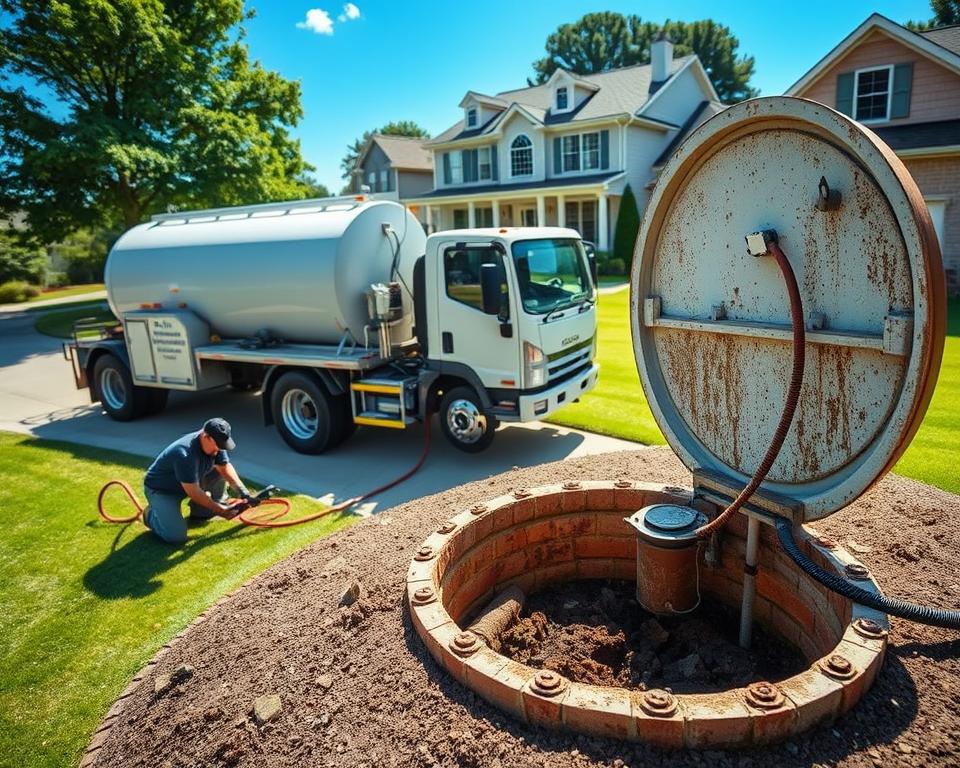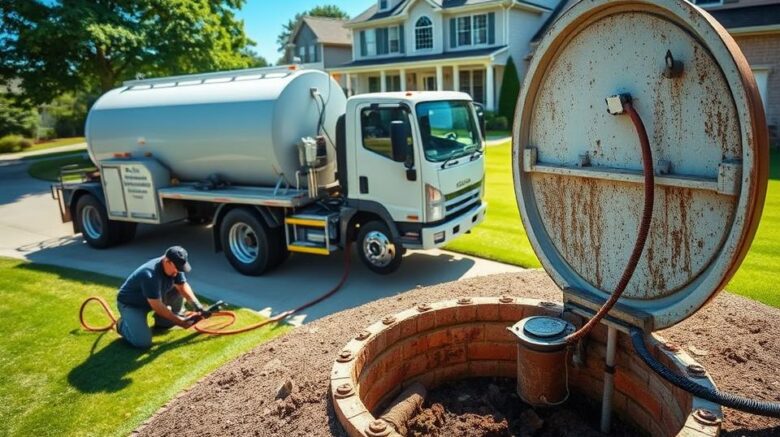Septic Aerator Unit: Essential Guide for Homeowners
Do you sometimes think about what enhances your aerobic septic system’s performance? The Septic tank aerator is the often-overlooked workhorse crucial for your system. Through this guide, you will get valuable know-how on the Septic air pump’s role. It’s key for a well-functioning, efficient Septic tank.
Appreciating the significance of a Septic tank air Pump can optimize your Septic system’s capabilities using septic service near me. It also protects your real-estate worth and surrounding ecosystem. Our handbook will present All in Sanitation, a well-regarded Septic industry leader. They’re prepared to handle your Septic aerator Pump requirements.
Primary Conclusions
- The Septic air Pump is crucial for air-driven Septic tanks.
- Maintaining your Septic system air Pump can improve overall system efficiency.
- Routine inspections lengthen the lifespan of your Septic tank air Pump.
- Choosing the proper Septic aerator Pump is key for top operation.
- All in Sanitation provides expert services for Septic air Pump support.
Getting to Know Aerobic Septic Systems
Aerobic Septic systems present a more effective waste treatment method by using oxygen. This method employs aerobic bacteria flourishing in well-oxygenated environments. These bacteria are faster in digesting organic matter. With the help of Septic aerator Pumps, these systems ensure a constant oxygen supply, accelerating the waste decomposition process.
These systems perform well in reducing sludge buildup, owing to the efficiency of aerobic bacteria. This cut in solid waste means less maintenance and tank Pump-outs is required. Additionally, they reliably process wastewater, producing barely any odor. This produces a improved environment for homeowners and the community overall.
To ensure these systems operate smoothly, it’s important to know the key Septic system components. These include the Septic tank, oxygenation chamber, and effluent Pump. Each component plays an important part, especially the air Pump. It drives oxygen into the tank, essential for the aerobic bacteria’s efficiency.
Value of the Septic Air Pump
The Septic air Pump is pivotal in the performance of aerobic Septic systems. It serves as the system’s “breathing mechanism,” supplying the critical oxygen needed. This oxygen allows aerobic bacteria to operate efficiently and digest waste quickly. If the Pump fails, the system’s capability drops, causing sludge accumulation and possible odors.
Such issues can hamper Septic system operations and lead to environmental hazards. By recognizing how critical the Septic air Pump is, homeowners can take proactive steps. They can keep its top function through routine care. This wards off failures, avoids costly repairs, and protects the aerobic system’s condition.
Key Benefits of Using a Septic Air Pump
Utilizing a Septic air Pump significantly boosts the effectiveness of Septic systems. Septic air Pumps are crucial as they fast-track the processing of waste. This is realized by oxygenating the treatment process, stimulating aerobic bacteria growth. These bacteria are essential for efficient waste treatment.
They’re also important in lowering foul smells. Due to more active aerobic processes, waste is treated faster, thus lessening odors. This creates a nicer atmosphere for homeowners.
Another important benefit is the drop in sludge buildup. Consequently, tanks need less frequent Pumping, conserving both money and time. Enhanced processing not only saves costs but also increases the lifespan of the drain field.
Servicing these Pumps well means less frequent repair costs and meeting regulatory standards. Thus, the pluses of Septic air Pumps extend past for homeowners. They also enhance environmental health by raising waste management practices.
| Benefit | Description |
|---|---|
| Fast Waste Breakdown | Heightened aerobic activity accelerates the decomposition process. |
| Minimized Odor Emissions | Optimized treatment efficacy creates fewer odors. |
| Reduced Sludge Buildup | Less frequent Pumping and maintenance are required. |
| Extended Drain Field Life | Better treatment equals a healthier drain field. |
| Cost Savings | Lower probability of repairs and regulatory compliance cost. |

Choosing the Right Septic Air Pump
Choosing the best Septic air Pump is vital for an well-running aerobic system. Homeowners should assess various factors for the ideal match. The dimensions of the tank and the airflow needs are important the Pump’s performance.
To select well, it’s helpful to recognize the air Pumps available. There are mainly two types: linear diaphragm Pumps and rotary vane Pumps. Each delivers distinct advantages, which should be matched with your home’s particular demands and usage pattern.
Electric efficiency also should be considered. Picking a Pump that minimizes energy use while providing the needed airflow can offer lower utility bills. Assistance from All in Sanitation specialists can be extremely useful. They make certain the Pump you choose matches your system’s requirements precisely.
Popular Categories of Septic Air Pumps
Homeowners can make better choices by recognizing the multiple Septic air Pumps available. There are mainly two types: diaphragm Pumps and rotary vane Pumps. Each has its unique functions and benefits.
Diaphragm Pumps, famous for their silent operation, are favored for residential Septic systems. They maintain energy efficiency while delivering reliable air delivery. Their reliable performance matches smaller systems, meeting the needs of many homeowners.
Rotary vane Pumps, however, are better suited for bigger or commercial systems. These Pumps provide higher capacity, necessary for handling bigger loads. Their solid build allows efficient operation in extensive Septic systems.
| Type of Pump | Best Use | Advantages |
|---|---|---|
| Diaphragm Pumps | Residential Systems | Quiet operation, energy-efficient, reliable air flow |
| Rotary Vane Pumps | Larger or Commercial Systems | Powerful performance, high capacity, durable construction |
Recognizing the contrasts in Septic air Pumps is vital for upgrades or replacements. Each Pump type provides particular attributes to address various needs. This secures peak performance for any system.
Clues Pointing to a Septic Air Pump Replacement
Homeowners must watch for Pump failure signs in their Septic systems. Some symptoms suggest the need for a Septic air Pump replacement. These keep the system running smoothly. Spotting these promptly prevents serious issues.
Signs of potential problems include:
- Unusual noises from the Pump, like clanking or vibrating, might suggest internal damage.
- A clear lack of air output reveals the Pump isn’t functioning properly, reducing efficiency.
- Regular electrical problems, such as blown fuses or voltage drops, could point to overloading.
- Visible damage on the Pump unit, with fractures or leaks, requires quick action.
- Bad smells in the yard often signal a compromised Pump, showing ineffective effluent aeration.
Finding these signs early heads off costly fixes or total system failure. Conducting periodic reviews assists in finding these issues. It also shows if you require a new Septic air Pump.
Upkeep Advice for Your Septic Air Pump
For an well-running Septic air Pump, periodic care is necessary. This ensures that that your system runs well. Homeowners can employ several simple care strategies for maximum results.
Half-yearly, carry out a careful inspection for wear or damage. It is also important to swap out the filters as suggested. This reduces clogs that could hamper efficiency.
The Pump should rest on a stable base to minimize vibrations, which could harm it over time. A protective cover is important too. It shields against debris and water, keeping the Pump’s functionality.
Diligent care can notably prolong the life of your Pump. In turn, this enhances the Septic system’s performance collectively.
| Maintenance Task | Frequency | Benefits |
|---|---|---|
| Inspect Pump for damage | Every 6 months | Identifies issues early |
| Replace filters | As needed | Maintains airflow |
| Check surface stability | Annually | Minimizes shake |
| Clear debris around Pump | Monthly | Maintains airflow |
Fitting Your Septic Air Pump
Accurate installation of your Septic air Pump is critical for its reliable operation. Initially, pick a secure, moisture-free area for placement. The chosen spot should securely bear the Pump’s weight easily.
To properly install your Pump on your own, heed the following guidelines:
- Collect all necessary items, including the Pump, a power source, and hose fittings.
- Carefully read the manufacturer’s guidelines before commencing your installation.
- Confirm every connection is sealed to prevent air leaks that impact performance.
- After assembly, perform a test to check the system works as intended.
If the installation process looks challenging, call All in Sanitation. Their professionals can sidestep common errors, guaranteeing your setup complies with necessary safety requirements.
Advantages of Using All in Sanitation for Your Septic Air Pump Solutions
When choosing a Septic service provider, the choice is significant. All in Sanitation differentiates itself by supplying dependable Septic air Pumps. They satisfy wide-ranging homeowner requirements with a wide selection of high-grade products. This makes sure customers find an appropriate match for their Septic systems.
What really sets apart All in Sanitation is not solely their broad product lineup. Their commitment to superior customer service is just as important. Homeowners benefit from knowledgeable support, steering them toward trusted Septic solutions. This joint effort is essential to customize each solution to fulfil specific needs.
All in Sanitation also puts first aftercare to secure lasting satisfaction. Their devotion continues beyond the initial sale. They supply ongoing support to maintain Septic systems functioning optimally for the foreseeable future.
Expense Overview for Septic Air Pumps
Understanding the financial elements associated with Septic air Pumps is important for homeowners operating aerobic Septic systems. At first, one faces the initial cost, which includes the Pump and required accessories. Installation expenses change, in line with the system’s complexity and any modifications required.
Ongoing upkeep forms an additional cost layer. Regular inspections can fend off bigger issues, in the long run yielding savings. Homeowners should set aside funds for Septic maintenance to retain the Pump’s effectiveness and life expectancy. Such planning prevents expensive repairs later on, highlighting the advantage of proactive maintenance.
| Cost Component | Average Cost Range |
|---|---|
| Septic Air Pump | $500 – $1,200 |
| Installation | $300 – $800 |
| Annual Maintenance | $150 – $400 |
| Potential Repair Costs | $1,000 – $5,000 |
Itemizing Septic air Pump expenses into individual parts assists homeowners in budget planning. This detailed approach ensures the system’s consistent operation and their confidence.
In Summary
For homeowners with aerobic Septic systems, looking after Septic systems is key. The proper Septic air Pump boosts waste processing and prolongs your system’s life. Committing to consistent service and promptly addressing issues stops expensive repairs and disruptions.
Opting for a Septic air Pump requires consideration. This guide showed how to decide intelligently about installation and replacement. With All in Sanitation’s help, you can handle your Septic systems’ complexities confidently.
Attending to your Septic air Pump supports your system’s performance and life span. It ensures a efficient and effective operation over time. Don’t forget, your home’s wastewater management benefits greatly from consistent upkeep.
